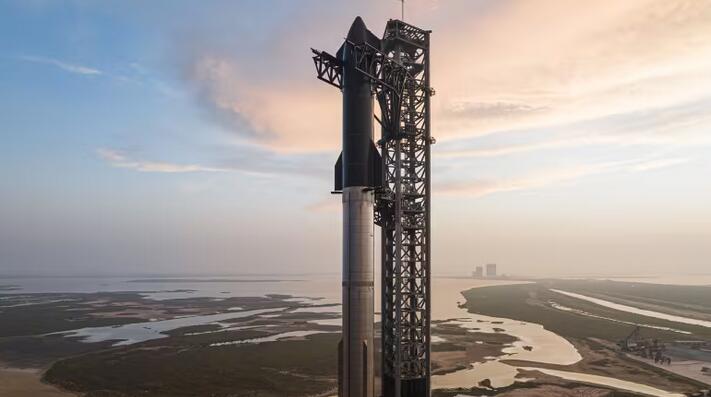SpaceX launches, lands 4th test launch of its 37-storey Starship rocket

SpaceX’s massive Starship blasted off into the Texas sky this morning in its fourth test and appeared to reach all its test goals.
The rocket lifted off from SpaceX’s Starbase at 8:50 a.m. ET, with 32 of its 33 engines functioning.
Just as with SpaceX’s Falcon 9 rocket, the first stage, or Super Heavy, is meant to be reusable and return to Earth shortly after launching. The second stage (also called Starship) would house cargo or future astronauts and also be fully reusable.
Successfully landing the pair — Super Heavy in the Gulf of Mexico and Starship in the Indian Ocean — were the main goals for this test, SpaceX said ahead of the launch.
After liftoff, the first stage and second stage separated as planned. The first stage met its goal and splashed down in the Gulf of Mexico (neither the first nor the second stage were planned to be recovered in this test).
Then, after roughly 40 minutes of cruising, the ship began its fiery descent through the atmosphere.
Nail-biting video showed one of the ship’s flaps taking heavy damage. It seemed to be barely holding on.
To the surprise of many people, including SpaceX’s own commentators, it held on to the very end, making it through the atmosphere. The ship fired its landing burn engines and appeared to make a successful splashdown in the Indian Ocean.
WATCH | SpaceX launches and lands massive Starship
After blasting off from Boca Chica, Texas, SpaceX successfully landed the two stages of its Starship, even after one of the ship’s fins fell apart during re-entry. CREDIT: SPACEX
Getting Starship to work as it should isn’t just a flight of fancy for SpaceX: It’s a critical component for NASA’s return to the moon. A version of Starship called the Human Landing System, or HLS, is needed to land astronauts on the surface of the moon as part of NASA’s Artemis program.

A variation of Starship, called the Human Landing System, will dock with the space agency’s Orion spacecraft for the planned 2026 Artemis III mission, then shuttle a pair of astronauts to the lunar surface.
Incremental steps
SpaceX has met many of its goals in testing this behemoth. The first, in April 2023, was a test to see if it would be capable of lifting off the pad, and it did. However, it severely damaged the launch pad in doing so, and blew up four minutes into its flight.
In the second launch, in November 2023, SpaceX tested its “hot staging” where the rocket of the second stage ignites just before the pair separate. While that was successful, the first stage was lost in an explosion, and the second stage made it to suborbit before it, too, exploded.
- Moon missions, meteors, a solar eclipse and more: Reasons to keep your eyes on the skies in 2024
-
Video
Astronauts finally blast off on Boeing’s new Starliner spacecraft
The third launch, on March 14, was a test of several more components, including a boostback burn where the first stage uses 13 of its 33 engines to guide it to where it would land (in this case, it would make a water landing in the Gulf of Mexico). However, it had engine issues and failed to achieve a soft water landing.
Starship also reached its full ascent and began to re-enter the atmosphere — which was a test of the tiles that protect the spacecraft as it heats up during re-entry — but an unplanned roll caused it to break up. It also opened and closed its payload bay door.
WATCH | The moment SpaceX’s Starship re-entered Earth’s atmosphere in March:
External cameras captured the plasma field generated as SpaceX’s Starship re-entered Earth’s atmosphere during the third test flight of the company’s mega rocket on Thursday. The company later said the spacecraft was destroyed during re-entry.
Perhaps most importantly for NASA , it tested a propellant transfer within the rocket. For the Artemis missions to the moon, SpaceX will have to prove that it can do this between two ships. This was just the first step.
While not everything went as planned in the last launch, SpaceX regarded it as a successful testing of crucial components. That’s SpaceX’s modus operandi: Test things in the real world.
“SpaceX is doing what SpaceX is good at, which is getting the flight test off and running, and learning from the flight test, taking what they learned and get it into the next one,” said Dan Dumbacher, an engineer and former NASA official who is now the CEO of the American Institute of Aeronautics and Astronautics.
WATCH | Why SpaceX rocket explosion isn’t hampering plans for Mars mission:
The SpaceX Starship rocket is a critical part of NASA’s plans. CBC’s science reporter Nicole Mortillaro explains why the explosion of the massive rocket isn’t hampering plans to send astronauts to Mars.
- Farmer says he’s not the only one to find space junk in his part of Saskatchewan
-
Analysis
Space junk is raining from the sky. Who’s responsible when it hits the Earth?
Ahead of the launch, Canadian Jordan Bimm, a postdoctoral researcher at the University of Chicago and a space historian, said there’s a lot riding on SpaceX’s latest uncrewed test flight of Starship.
“So far, the public has accepted the iterative design approach, and have tolerated the failure-as-progress-toward-success model,” he said. “A failure to push further towards a complete, successful flight than previous tests could erode public acceptance and tolerance of the iterative approach.”
Related News
Trade war, slumping border traffic: What does that mean for the Gordie Howe bridge?
Amid U.S. President Donald Trump’s tariffs which have triggered a trade war with Canada, cross-border trips haveRead more
Trump administration threatens Harvard’s foreign enrolment, tax-exempt status
U.S. Homeland Security Secretary Kristi Noem speaks during an event on April 9, in Washington,Read more



